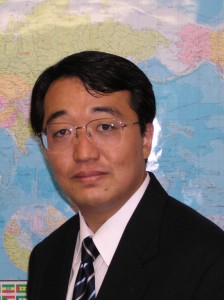緊張と統合:内村鑑三におけるキリスト教と日本の精神
このシリーズでは、私が1994年に執筆した統一神学大学院(Unification Theological Seminary)の神学課程修士論文(Divinity Thesis)を日英二か国語で掲載している。
6.無教会と日本社会の続き
一般的にカトッリクもプロテスタントも、このような政策に対して示した態度は妥協的なものであった。1890年までに長崎で開かれた会議では、ローマ・カトリックの信徒が神社において愛国的な儀式に参加することが許可された。カトリックもプロテスタントも共に、国家神道は「非宗教的」であるという解釈を受け入れた。彼らの見解によれば、非宗教的、愛国的行為としての神社における敬礼は、すべての日本臣民が行い得るものであると言う。このようにして彼らは国粋主義的な政権の要求をのんだのである。このような脈絡から見たときに、内村は個人の良心に立脚してキリスト教信仰の独立を勇気をもって主張した、希有なるキリスト教徒であったと言える。
B.不敬事件
既に述べたように、内村自身には明治天皇を冒涜するつもりはなかった。彼を躊躇させたものは、宸署の前で敬礼することの意味であった。すなわち、ただ敬意を表しているのか、礼拝しているのかという問題である。この事件の前に、二人の尋常師範学校の生徒が皇室に対して敬意を払う事ことに関して、『基督教新聞』の紙上で質問している。編者は皇室に対して敬意を払い、その前に頭を下げる事は、ちょうど両親や先祖に敬意を払い、その前でお辞儀をすることと同じであるから問題ないと答えた。しかし彼は、問題は尊敬の表現方法であり、それが「神祗」に対する崇拝であるかの様に見あやまられないように注意しなければならない、と付け加えている。しかし実際にはどこまでが尊敬の表現であり、どこからが崇拝になるかという線を引くのは困難であるから、彼の言っていることは非常に曖昧である。しかしこれは当時のキリスト教徒達の一般的な態度をよく表している。これに比べると、内村のこの問題に対する態度は極めて深刻なものである。
その日、1891年1月9日、第一高等中学校の教師達は、ある儀式に参加することを要請され、そこで彼らは一人一人前に出て、前年の秋に発布され、天皇御自身が宸署した教育勅語の前で、従順を示す最敬礼をすることになっていた。内村自身の表現を借りれば、「疑いをもってためらいながら、私は、自分のキリスト教的良心を傷つけることのない道を選んで、60人の教授・・・と一千人以上の生徒達が、おごそかに列席しているなかで、私は、自分の態度をきめて、頭を下げませんでした! 私には恐ろしい瞬間でした。ただちに自分の行動の結果がわかったからです。」(1891年、ベルへの手紙、原英文、鈴木範久訳)すぐに激しい糾弾が始まった。
VI. Mukyokai and Japanese Society. (Cont.)
The general attitude of both the Catholics and the Protestants towards this policy was one of compromise. As early as 1890 a council meeting at Nagasaki permitted Roman Catholics to take part in patriotic ceremonies at Shinto shrines. Both the Catholics and the Protestants in Japan accepted the government’s interpretation of State Shinto as “nonreligious.” According to their view, obeisance at the Shinto shrines as a nonreligious, patriotic act could be performed by all Japanese subjects, thus meeting the requirements of the nationalistic regime.(13)In this context, Uchimura was a rare Christian who courageously insisted on the independence of the Christian faith, grounded on individual conscience.
B. The Lese Majesty Incident.
As I mentioned above, Uchimura himself had no intention to blaspheme the Emperor. What made him hesitate was the meaning of bowing before the Imperial signature; just paying respect or worshipping? Before this incident, two elementary school students asked a question about the respect for the Imperial Family in a Christian newspaper (Kirisutokyo Shimbun). The editor replied that it is no problem to pay respect for the Imperial Family and bow before them; it is just like you pay respect for and bow before your parents and ancestors. He added, however, the problem is the expression of respect; you should be careful not to be seen as worshipping him in your expression of respect. Since it is very difficult to draw the line between the expression of respect and worship, his answer was quite ambiguous. However, this represented the general attitude of contemporary Christians.(14)Compared to this, Uchimura’s attitude to this issue was quite serious.
On that day, January 9, 1891, the teachers of Dai Ichi Koto Chu Gakko (First Higher Middle School of Tokyo, the present Tokyo University) were compelled to participate in a ceremony, in which they were expected to step forth one by one and make a full bow of obedience before a personally signed copy of the Imperial Rescript on Education, which had been promulgated the previous fall. According to Uchimura’s own expression: “Hesitating in doubt, I took a safer course for my Christian conscience, and in the august presence of 60 professors … and over thousand students, I took my stand and did not bow! It was an awful moment for me, for I instantly apprehended the result of my conduct.”(15)Soon fierce accusation began.
(13)Latourette, Advance Through Storm: A.D. 1914 and After, with Concluding Generalization, vol. VII of A Hitory of the Expansion of Chritianity, (Grand Rapids, Michigan, Zondervan Publishing House, 1970), Vol.7, p.382.
(14)op cit, Norihisa Suzuki, Vol.1, p.94
(15)Letter to Bell, March 6, 1891. Zenshu, XX, p.207
